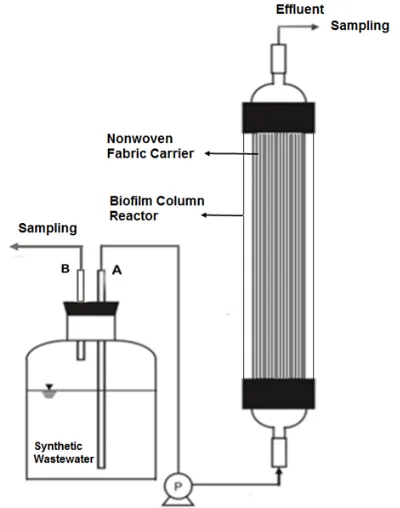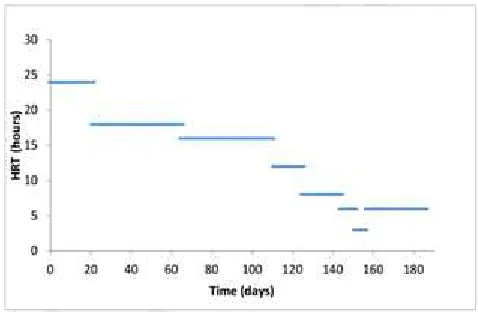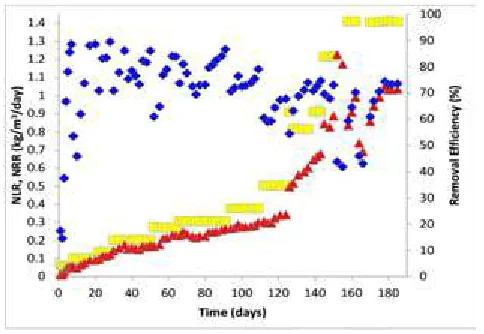Fundamental and Applied Chemistry
Article
http://ijfac.unsri.ac.id
Nitrogen Removal by Anammox Biofilm Column Reactor at Moderately
Low Temperature
Tuty Emilia Agustina1*, Novia1, Gusti Diansyah2, Michihiko Ike3, and Satoshi Soda3
1
Department of Chemical Engineering, Universitas Sriwijaya, Indonesia
2Department of Marine Science, Universitas Sriwijaya, Indonesia
3Bio-Environmental Engineering Laboratory, Osaka University, Japan
*
Corresponding Author: tuty_agustina@unsri.ac.id
Abstract
The anaerobic ammonium oxidation (anammox) as a new biological approach for nitrogen removal has been considered to be more cost-effective compared with the combination of nitrification and denitrification process. However, the anammox bioreactors are mostly explored at high temperature (>300C) in which temperature controlling system is fully required. This research was intended to develop and to apply anammox process for high nitrogen concentration removal at ambient temperature used for treating wastewater in tropical countries. An up-flow biofilm column reactor, which the upper part constructed with a porous polyester non-woven fabric material as a carrier to attach the anammox bacteria was operated without heating system. A maximum nitrogen removal rate (NRR) of 1.05 kg-N m3 d-1 was reached in the operation days of 178 with a Total Nitrogen (TN) removal efficiency of 74%. This showed the biofilm column anammox reactor was successfully applied to moderate high nitrogen removal from synthetic wastewater at moderately low temperature.
Keywords: Anammox, biofilm column reactor, ambient temperature, nitrogen removal
Abstrak (Indonesian)
Anaerobic ammonium oxidation (anammox) sebagai salah satu pendekatan baru secara biologi untuk menghilangkan nitrogen dianggap lebih murah biayanya dibandingkan dengan kombinasi proses nitrifikasi dan denitrifikasi. Namun, bioreaktor anammox kebanyakan dieksplorasi pada suhu tinggi (> 300C) dimana diperlukan sistem pengendalian suhu. Penelitian ini bertujuan untuk mengembangkan dan menerapkan proses anammox untuk menghilangkan nitrogen dengan konsentrasi tinggi pada suhu lingkungan yang digunakan untuk pengolahan air limbah di negara tropis. Dalam penelitian ini, dipakai sebuah Reaktor kolom biofilm up-flow, dimana pada bagian atas kolom ditempatkan bahan poliester non-woven berpori sebagai pembawa untuk menempelkan bakteri anammox, telah dioperasikan tanpa sistem pemanas. Laju penghilangan nitrogen maksimum (NRR) sebesar 1,05 kg-N m3 d-1 telah dicapai pada hari operasi ke 178 dengan efisiensi total penghilangan nitrogen (TN) sebesar 74%. Hal ini menunjukkan bahwa reaktor kolom biofilm anammox telah berhasil diterapkan untuk menghilangkan nitrogen dengan konsentrasi cukup tinggi dari air limbah sintetis pada suhu yang cukup rendah.
INTRODUCTION
Nitrogen pollution from industrial wastewater, domestic wastewater and agricultural wastewater streams is recently considered as one of critical environmental problems for water resource protection. The discharge of untreated wastewater containing high nitrogen concentration is known to be one of the causes of eutrophication and oxygen depletion as a result of an abundance of nitrates and phosphates in surface water [1].
Conventionally, ammonium nitrogen from wastewater has been removed by a combination of biological process between nitrification and denitrification. This system requires an oxygen supply as electron acceptor during nitrification process. Besides an additional carbon source must sometimes be supplied for anoxic denitrification. Thus, this leads to increase the operational cost of the full-scale treatment plant.
Recently, anaerobic ammonium oxidation (anammox) has been recommended as a new biological approach for ammonia removal from wastewater. Anammox is based on the utilization of
Compared to the conventional nitrification and denitrification process, the partial nitrification-anammox process is considered to be more cost-effective due to less required oxygen demand and no extra additional carbon source [3]. In the partial nitrification and anammox process, half of ammonium is partly oxidized to nitrite and subsequently anammox bacteria oxidize anaerobically the ammonium using nitrite to dinitrogen gas. However, in the practice, an anammox reactor system with highly efficient biomass retention and with high mass transfer system is reactor system capable of retaining the biomass as effective as possible and with a highly efficient substrate transfer for treating high ammonium nitrogen concentration at moderately low temperature (25-27oC). This research has opened an operational window for treating fertilizer wastewater with high ammonium concentration applied in tropical countries. In many tropical countries, the availability of sunlight is abundant. It is possible to develop a bioreactor system which equipped with microorganism living in moderate low temperature, without any water heating systems. By using the appropriate bacteria and reducing additional cost caused by heating apparatus, the low cost bioreactor system could be improved. The objective of this research is to develop and to apply anammox process for high nitrogen concentration removal
at ambient temperature used for treating wastewater in carrier to effectively attach the Anammox bacteria. The column in Anammox reactor was inoculated with KSU-1 strain from Osaka University and operated at ambient tropical temperature without any water heating systems (25-27oC). The reactor was always enclosed with a black vinyl sheet to prevent the inhibition of the growth of photosynthetic bacteria [7]. Peristaltic pumps (Watson Marlow, 500 series) were used to control the feed inflow rate. The reactor was run without recycling and the effluent was driven by gravity. Samples were taken from the inflow and overflow lines regularly to analyze nitrogen reduction.
Figure 1. Schematic research equipment of biofilm column reactor
Feeding Media
The bioreactor’s influent was a synthetic wastewater consisted of (NH4)2SO4, NaNO2,
the chemicals were supplied by Merck. Concentrations of ammonium and nitrite were increased stepwise over the ranges. The Anammox enrichment medium had a bicarbonate-buffering agent instead of phosphate, given the possible toxicity of the latter.
Analytical methods
Ammonium nitrogen (NH4+-N) and Nitrite nitrogen (NO2--N) was determined with the colorimetric method and nitrate nitrogen (NO3
--N) with the ultraviolet spectrophotometric screening method [8]. pH and DO was measured using a pH meter (F55, Horiba Ltd, Japan) and a DO meter (OM-51, Horiba Ltd, Japan).
RESULT AND DISCUSSION
Figure 2. Evolution of the nitrogen concentration in the Influent the effluent along the operational Period.
The biofilm column anammox reactor has been operated for 185 days. The reactor was continuously fed with ammonium and nitrite with a ratio of 1:1.1. The time course of influent and effluent nitrogen concentrations shown in Figure 2. As can be observed from this figure, during the operation, the influence of Total Nitrogen concentration had increased up to 350 mg/L (with 174 mg/L NH4+-N and 176 mg/L NO2—N approximately) in
the end of the experiment. Meanwhile, Hydraulic Retention Time (HRT) had decreased from 24 hours in the beginning Until 6 hours in the day of 145 of total operations (Figure 3).
The reactor was started up with an influent Total Nitrogen concentration of 60 mg/L resulting a feed loading rate of 0.06 kg-N m-3 d-1. In early starting up period, the biomass inoculated into reactor was easy to wash out due to unwell attached of biomass. This shows a slower process during the start-up phase compared to the anammox reactor
studied by Ma et al. [9]. In their study, a hybrid reactor was installed and performed during day 1-39 resulting a rapidly increasing of the Nitrogen Loading Rate (NLR) from 0.35 to 1.2 kg-N m-3 d-1 [9]. It is mainly because of temperature difference applied in this project. In our study, the biofilm column reactor was not equipped with a temperature controller, resulting the temperature varied from 25 to 27oC.
Figure 3. Time course of HRT during reactor operation
As can be seen in Figure 4, as the capacity of nitrogen removal of the system going up after a successful start-up, both the ammonium and nitrite concentrations in the influent flows were gradually increased from 60 to 350 mg/L. Besides, from days 121 to 145, the HRT was reduced from 12 to 6 hours. Consequently, the NLR was doubled from 0.6 to 1.4 kg-N m-3 d-1. During this period, a relatively high TN removal efficiency average was 75.3%. This value was lower compared with the maximum nitrogen removal based on anammox stoichiometry due to NO2—N limitation. In addition, a maximum
Figure 4. Time course of total NLR, NRR and Nitrogen removal efficiency (◊ : TN removal
efficiency; □ : NLR; Δ : NRR)
However, higher total nitrogen removal efficiency achieved was desired. It was reported in a recent study by Reza and Cuenca (2016) that nitrogen removal began 140 days after start-up. In their study about simultaneous biological removal of nitrogen and phosphorus in a vertical bioreactor, NH3-N, NO2
-and NO3-N concentrations in the effluent were
unsteady for approximately 240 days of the reactor operation. The nitrogen removal reached steady state conditions as concentrations were stable and consistent from day 240 until the end of the experiments (day 350) delivering above 90% total nitrogen removal efficiency [12]. The biofilm column reactor has been successfully operated for treating nitrogen from synthetic wastewater at moderately low temperature in this research, but the experimental result has shown total nitrogen removal efficiency of 74% was reached by 178-day operation. It might be because of the operation time was not long enough to allow the bacteria to get the optimum biomass for
Nitrogen removal treatment of synthetic wastewater by using anammox biofilm column reactor was successfully operated. In this study, the application of anammox process for treating the wastewater at moderately low temperatures of 25-27
0
C was utilized without any water heating systems. Total nitrogen removal efficiency of 74% in 178 days of reactor operation with a maximum NRR of 1.05
kg-N m3 d-1 was reached. This biofilm column reactor could be a suitable system for nitrogen removal using anammox biomass at ambient tropical temperature. The results showed that the operating cost of operating anammox biofilm column reactor could be reduced
ACKNOWLEDGMENT
Authors would like to thank Lembaga Penelitian Universitas Sriwijaya, Indonesia for financial support, and the Bio-Environmental Engineering, Osaka University, Japan. Thanks also addressed to the Waste Treatment Technology Laboratory, Chemical Engineering Sriwijaya University for laboratory support.
REFERENCES
[1] Y.-H. Ahn, H.-C. Choi, Autotrophic nitrogen removal from sludge digester liquids inupflow sludge bed reactor with external aeration, Process Biochem. vol. 41, pp. 1945–1950, 2016. [2] M. Strous, J.J. Heijnen, J.G. Kuenen, M.S.M.
[3] C. Trigo, J.L. Campos, J.M. Garrido, R. Mendez, Start-up of the Anammox process in a membrane bioreactor, J. Biotechnol. vol. 126, pp. 475–487, 2006. reactors for anoxic ammonium oxidation: Experiences from the first full-scale anammox reactor in Rotterdam, Water Res. vol. 41, pp. 4149–4163, 2007.
[6] W.R. Abma, W. Driessen, R. Haarhuis, M.C.M. Van Loosdrecht, Upgrading of sewage treatment plant by sustainable and cost-effective separate treatment of industrial wastewater, Water Sci. Technol. vol. 61, pp. 1715–1722, 2010.
[8] American Public Health Association (APHA), Standard method for the examination of water and wastewater, 22nd ed., American Water Work Association and Water Environment Federation, Washington DC, 2012.
[9] Y. Ma, D. Hira, Z. Li, C. Chen, K. Furukawa, Nitrogen removal performance of a hybrid anammox reactor, Bioresour. Technol. vol. 102, pp. 6650–6656, 2011.
[10]B. Ma, Y. Peng, S. Zhang, J. Wang, Y. Gan, J. Chang, S. Wang, S. Wang, G. Zhu, Performance of anammox UASB reactor treating low strength wastewater under moderate and low
temperatures, Bioresour. Technol. vol. 129, pp. 606–611, 2012.
[11]I. Zekker, E. Rikmann, T. Tenno, K. Kroon, A. Seiman, L. Loorits, H. Fritze, T. Tuomivirta, P. Vabamäe, M. Raudkivi, others, Start-up of low-temperature anammox in UASB from mesophilic yeast factory anaerobic tank inoculum, Environ. Technol. vol. 36, pp. 214–225, 2015.


